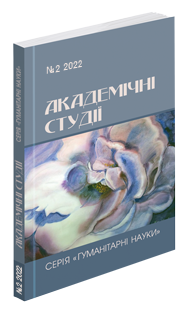Abstract
Gender issues are considered in the article based on the material of H. Melville's novel «Moby Dick». This work was the object of research from the point of view of feminist criticism, since gender problems in the contrast of female / male were not raised in the work. This figure depicts men's work, distant from women's problems by a boundless expanse of water. The signs of «women's writing» that are distinguished by feminist criticism characterize the type of perception of the artistic text (narrative strategy, mythological context, figurative system). These features were identified as masculine features of the work of the American writer. In the work of H. Melville, bright male (masculine) gender characteristics are embodied, which, according to feminist criticism, are considered according to the parameters of the symbolic (mythological), public and interpersonal. The hero-narrator combined various male types in himself – from the romantic storyteller Ishmael to the direct authorial intervention in the story of a researcher, philosopher, and artist. These narrative types have rational thinking, analysis, restrained emotionality, which characterizes purely «male writing». The subject of the author's image was a male team and male work, where the presence of women is not only limited, but also strictly prohibited. The gender dichotomy can be traced in the figurative system of the work, in particular in the mythological parallels that the author-narrator talks about. The sea space is both the chronotope of the work and its full-fledged hero. The archetypal symbol of the circle is connected with the mythic image of the ocean, which traditionally expresses the idea of unity, infinity and completeness, the highest perfection. Masculine features of the writer's style are leveled with the help of the central image of the unity of two earthly elements – water and sky, which symbolize the female and male essence, capable of endless birth of life. The author emphasizes the gender contrast and at the same time the unity of the two cosmogonic elements as feminine and masculine, using the terms «femininity» and «masculinity».
References
Ґендерні дослідження: монографія / За наук. ред. В. П. Кравця. Тернопіль: Богдан, 2013. 448 с.
Крістева Ю. Вибрані праці: Руйнування поетики. К.: Генеза, 2004. 306 с.
Мелвілл Г. Мобі Дік, або Білий Кит (пер. Юрія Лісняка). К. : Вид. група КМ-БУКС, 2016. 672 с.
Онацький Є. Українська мала енциклопедія: у 4 т. Т. 1. Київ : Університетське видавництво «Пульсари», 2016. 576 с.
Wiesner-Hanks, Merry (2019). Women and Gender in Early Modern Europe (4 ed.). Cambridge, UK: Cambridge University Press. 380 p. 6. Borges L. Sobre los clásicos. Madrid: Eterna Cadencia, 1997. 141 p.
Melville H. Moby Dick. Reading: Penguin Books, 1994. 536 p. (Penguin Popular Classics).
Tuttleton J. W. The character of Captain Ahab in Melville’s Moby-Dick: URL: http: //www.worldandy.com/ public/1998/february/ tuttleton. cfm#top. (Дата звернення 24.05.22).

